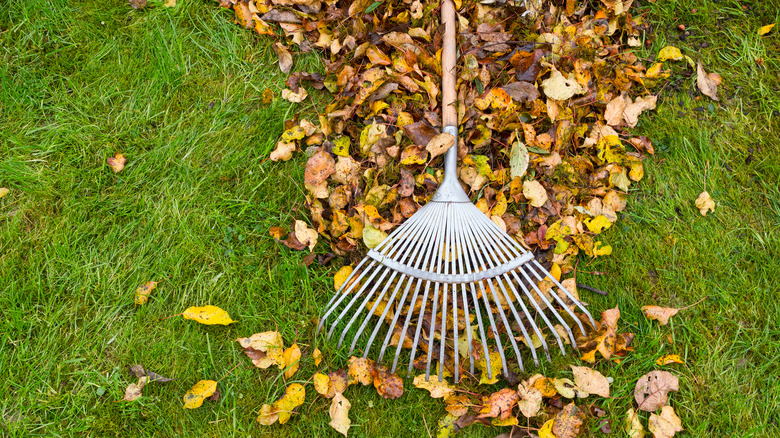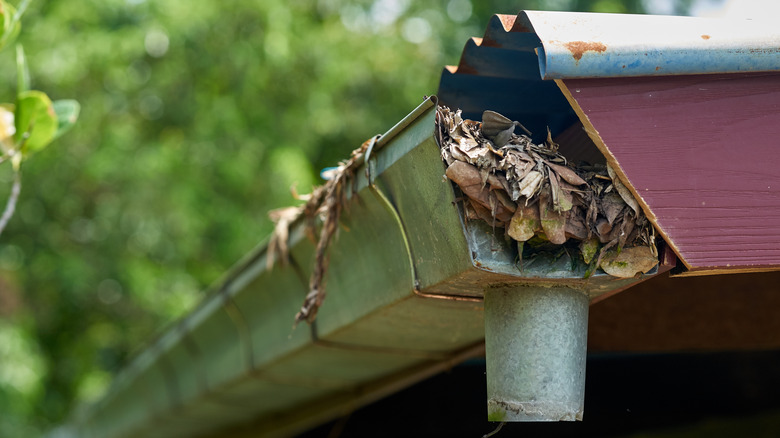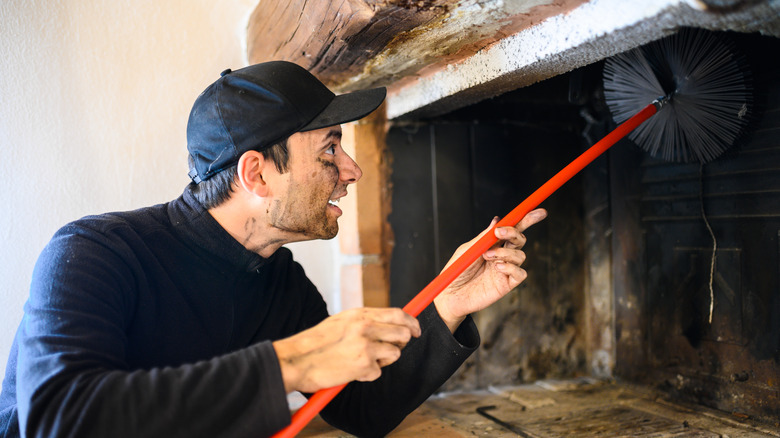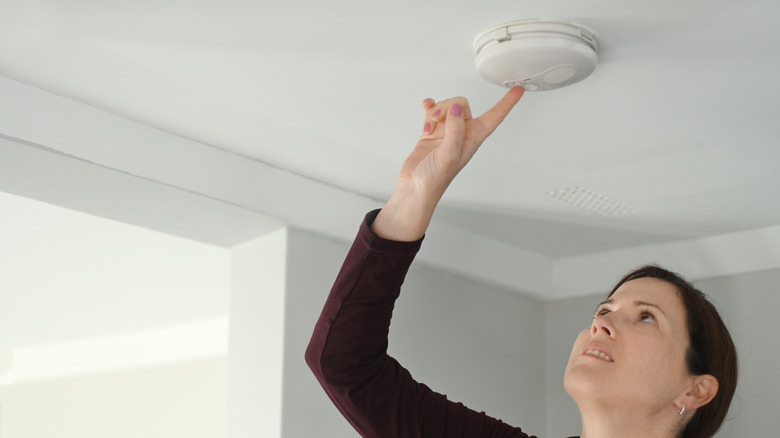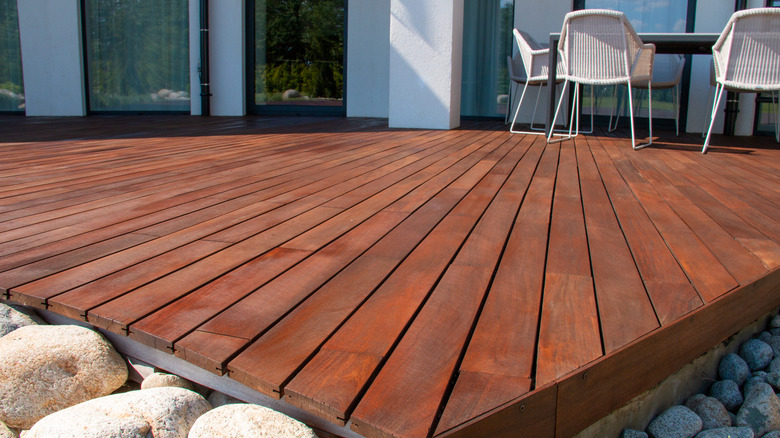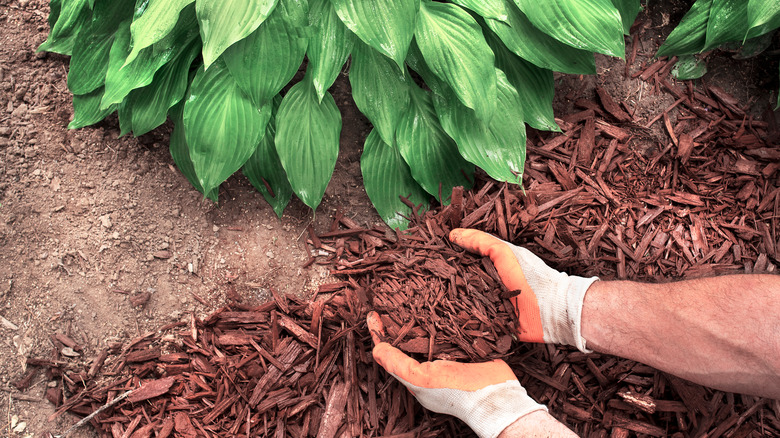5 Things To Do Around Your House And Garden This Fall
Fall is our annual reminder that summer fun and delayed sunsets don't last forever. Those chilly autumn mornings can also remind us to prep our house for the colder months ahead. The brief period between the end of summer and the early days of fall offers the perfect window of opportunity to ensure your indoor and outdoor areas are adequately prepared for the colder months ahead.
Jordan Spear, a contractor and featured speaker at the Toronto Fall Home Show, says that the onset of fall offers the perfect opportunity to take care of any incomplete tasks around the home that you've been putting off all summer because the weather is neither too hot nor too cold (via Livabl). "You'll find you are at your most productive when you're not sweating or freezing," he says. He also adds that if you have a maintenance or repair project that you aren't DIY-ing, contractors often have more availability during this time than they do during the peak months of summer. Additionally, certain building materials actually perform and install better during this time than they do when it's too hot and humid or when it's freezing cold out.
Waiting until the first snow falls and the temperatures freeze is too late to start wondering if your home is prepared. Here are five expert-recommended things to do around your home and garden before the colder weather sets in.
Clean your gutters
Cleaning your gutters before ice and snow make their first appearance is one of the most important aspects of annual home maintenance, and experts say that early autumn before the leaves fall is the best time to start.
Ned Stevens Gutter Cleaning states that because the accumulation of fall leaves can add a lot of additional weight to your gutters and put added strain on them, you should take proper care early in the fall season to ensure they are adequately cleaned out and ready for the inevitability of leaves. Summer thunderstorms are also notorious for damaging gutters in the form of branches, plant debris, and heavy rainwater, so the cleaning service also recommends that you repair any gutter damage prior to fall to ensure the additional weight of leaves doesn't harm them even more.
Leaves, especially when wet, can weigh down your gutters, which has the potential to damage your roof or lead to the obstruction of water flow — this is a formula for pooling water, basement flooding, and other damage. House Logic says that clogged gutters now can lead to ice dams in the winter, so ensure your gutters are inspected and regularly cleaned at the end of the summer.
Have your chimney and fireplace cleaned and inspected
Cozy nights by the fireplace are one of the best parts about bidding farewell to summer, and making sure your indoor fireplace is clean and in good working order will help keep you and your family safe and warm all season long. According to Doctor Flue, you should have your fireplace and chimney cleaned and inspected once a year. Ensuring this task is done before the temperatures drop is the best way to guarantee you and your family are kept safe during the first fire of the season.
Chimney says that a wood-burning fireplace that is consistently used has the potential for a buildup of creosote, which is a highly flammable substance that can lead to chimney fires. Creosote can make it harder for the person inspecting your fireplace and chimney system to detect a potential issue, which can ultimately be a big safety concern if something goes unnoticed. Regular cleaning can help eliminate the dangers of creosote buildup while also making the inspection process easier.
Gas fireplaces still need to be cleaned and inspected annually, as they present their own slate of problems. According to Doctor Flue, a gas fireplace's ceramic logs can deteriorate over time, which can clog vents and cause them to malfunction. There is also the risk of valve leaks and structure cracking.
Test smoke alarms and carbon monoxide detectors
As the colder weather returns and we head back inside to warm up, most people turn to various heating elements throughout their homes for additional warmth. The problem with common heating sources such as fireplaces, furnaces, and unvented space heaters is that they can produce carbon monoxide, an odorless, colorless gas that can be deadly if you are exposed to it for too long. This is why it doesn't come as a surprise that the majority of all carbon monoxide poisonings happen during the colder months (per Johns Hopkins Medicine).
It's crucial that your carbon monoxide detectors have fresh batteries and are in working order. If you don't have them installed in your home, make sure you do so prior to using any heating method, following the Environmental Protection Agency's recommendation of having at least one on every floor of the house and one in every sleeping area.
In addition to being potential sources of carbon monoxide output, The National Fire Protection Association also found that home heating elements are the second leading cause of all house fires. Ensuring the proper care when using any sort of heating device is the best way to prevent a fire, while putting fresh batteries in all of your smoke alarms and installing them everywhere you would install a carbon monoxide detector is essential for ensuring you and your family are prepared in the event of an emergency.
Stain your deck
Staining your deck during the fall is the best way to protect it this winter while ensuring it will be beautiful and ready for entertaining as soon as the snow and ice melt in the spring.
If you feel a little guilty for putting off your deck staining project all summer, don't worry — you waited until the perfect time. According to Plasticine House, applying your deck stain during the peak summer months when the amount of direct sunlight is at its highest can prevent the stain from applying properly. Not to mention, working outside in high temperatures and direct sunlight can be miserable and particularly exhausting, so waiting until the end of summer or early fall before it gets too cold is the perfect time.
You will want to apply the stain before fall comes to an end and all the trees drop their leaves, as having leaves falling onto your wet stain can create a mess and ruin your hard work.
Transition your garden from summer to fall
One of the best parts about fall is the transition from summer to fall gardens, which bring beautiful and unique flowers like the ever-popular mum that doesn't get to make an appearance during the hotter months.
According to Outdoor Living Today, when preparing your garden for fall planting and the coming colder months, the first thing you should do is simply examine and take inventory of your existing garden, making note of any areas that will need new soil and which plants need to be divided and/or moved inside. Additionally, you should examine the current state of your perennials and determine whether they need additional care and maintenance to help them survive the cold, wintery months ahead. Taking inventory is a good time to remove dead, spent plant material from your garden, which will help ensure that your fall plants have enough room to grow and are getting their fair share of nutrients from the soil.
Outdoor Living Today also says that fall is the best time to apply weed killer, as it will take care of any unwanted seeds that have ended up in your garden or lawn during the summer and will lead to fewer weeds to have to worry about in the spring. Adding mulch during this time will also help protect your perennials and the soil during the harsh winter months.
